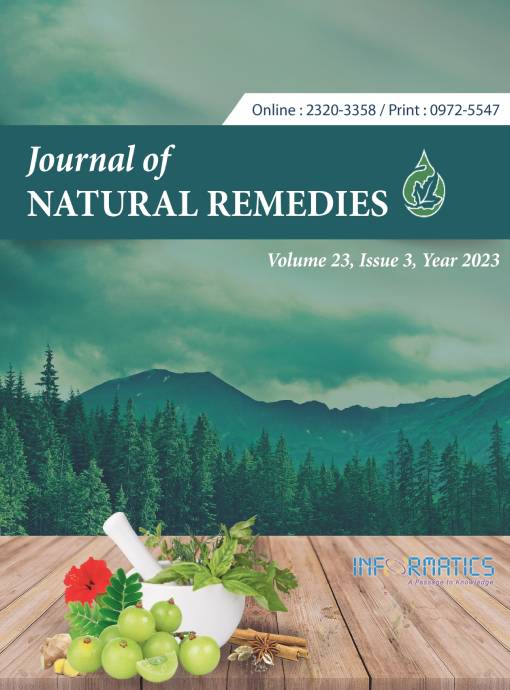Evaluation of Wound Healing Activity of Vernonia amygdalina Extract in Diabetic Rats
DOI:
https://doi.org/10.18311/jnr/2023/34089Keywords:
Diabetic, Excision, Incision, Luteolin, Vernonia amygdalinaAbstract
Excision and incision wound models were used to evaluate the wound healing activity on Wistar albino rats by applying the topical application of a prepared ointment. The wound healing potential was assessed by measuring the rate of the epithelization period, wound contraction, wound breaking strength, and histopathological parameters reference with povidone iodine ointment as standard. Higher rate of wound contraction (****P<0.0001), decrease in the period of epithelization (**P<0.01) higher wound breaking strength (****P<0.0001), and favorable histopathological changes were observed with the ointment containing 5% and 10% hydro-ethanolic extract of leaves. The data of this study indicated that hydro-ethanolic Vernonia amygdalina extract of leaves exhibited potent wound healing effects thus the study can be extended in future for the study of phytoconstituents which are giving the wound healing effect.
Downloads
Metrics
Downloads
Published
How to Cite
Issue
Section
License
Copyright (c) 2023 AvijitAvijit Mazumder, Bhavani Pentela, Sanjana, Vikas Gupta (Author)

This work is licensed under a Creative Commons Attribution 4.0 International License.
Accepted 2023-07-24
Published 2023-08-31
References
Zulkefli N, Zahari CNMC, Sayuti NH, Kamarudin AA, Saad N, Hamezah HS, Bunawan H, Baharum SN, Mediani A, Ahmed QU, Ismail AF. Flavonoids as potential woundhealing molecules: Emphasis on pathways perspective. International Journal of Molecular Sciences. 2023; 24(5):4607. https://doi.org/10.3390/ijms24054607 DOI: https://doi.org/10.3390/ijms24054607
Fulzele SV, Sattuwar PM, Joshi SB, Dorle AK. Wound healing activity of Hingvadya Ghrita in rats. Indian Drugs. 2002; 39(11):606-9.
Adly AA. Oxidative stress and disease: an updated review. Res J Immunol. 2010; 3(2):129-45. https://doi.org/10.3923/ rji.2010.129.145 DOI: https://doi.org/10.3923/rji.2010.129.145
Essawi T, Srour M. Screening of some Palestinian medicinal plants for antibacterial activity. Journal of Ethnopharmacology. 2000; 70(3):343-9. https://doi. org/10.1016/S0378-8741(99)00187-7 DOI: https://doi.org/10.1016/S0378-8741(99)00187-7
Ayoola GA, Coker HA, Adesegun SA, Adepoju-Bello AA, Obaweya K, Ezennia EC, Atangbayila TO. Phytochemical screening and antioxidant activities of some selected medicinal plants used for malaria therapy in Southwestern Nigeria. Tropical Journal of Pharmaceutical Research. 2008; 7(3):1019-24. https://doi.org/10.4314/tjpr.v7i3.14686 DOI: https://doi.org/10.4314/tjpr.v7i3.14686
Sofowora A. Medicinal plants and traditional medicine in Africa. Spectrum books Limited. Ibadan, Nigeria; 1993. p. 150-6.
Rajasree PH, Vishwanad V, Cherian M, Eldhose J, Singh R. Formulation and evaluation of antiseptic polyherbal ointment. International Journal of Pharmacy and Life Sciences. 2012; 3(10).
Bostani M, Rahmati M, Mard SA. The effect of endurance training on levels of LINC complex proteins in skeletal muscle fibers of STZ-induced diabetic rats. Scientific Reports. 2020; 10(1):8738. https://doi.org/10.1038/s41598- 020-65793-5 DOI: https://doi.org/10.1038/s41598-020-65793-5
Yaduvanshi B, Mathur R, Mathur SR, Velpandian T. Evaluation of wound healing potential of topical formulation of leaf juice of Tridax procumbens L. in mice. Indian Journal of Pharmaceutical Sciences. 2011; 73(3):303-6. 10. Neuman RE, Logan MA. The determination of collagen and elastin in tissues. Journal of Biological Chemistry. 1950; 186(2):549-56. https://doi.org/10.1016/S0021- 9258(18)56248-7 DOI: https://doi.org/10.1016/S0021-9258(18)56248-7
Lee KH. Studies on the mechanism of action of salicylates III. Effect of vitamin A on the wound healing retardation action of aspirin. Journal of Pharmaceutical Sciences. 1968; 57(7):1238-40. https://doi.org/10.1002/jps.2600570736 DOI: https://doi.org/10.1002/jps.2600570633
Nayak BS, Pereira LMP. Catharanthus roseus flower extract has wound-healing activity in Sprague Dawley rats. BMC Complementary and Alternative medicine. 2006; 6(1):1-6. https://doi.org/10.1186/1472-6882-6-41 DOI: https://doi.org/10.1186/1472-6882-6-41
Murti K, Kumar U. Enhancement of wound healing with roots of Ficus racemosa L. in albino rats. Asian Pacific Journal of Tropical Biomedicine. 2012; 2(4):276-80. https:// doi.org/10.1016/S2221-1691(12)60022-7 DOI: https://doi.org/10.1016/S2221-1691(12)60022-7
Corrêa AC, Oliveira AK, Dourado DM, Facco GG, Bento LM, Rivero-Wendt CL, Matias R. Pouteria ramiflora leaf extract on emulgel in wound healing activity in diabetic rats. Brazilian Journal of Biology. 2021; 82. https://doi. org/10.1590/1519-6984.239378 DOI: https://doi.org/10.1590/1519-6984.239378
Güzel S, Özay Y, Kumaş M, Uzun C, Özkorkmaz EG, Yıldırım Z, Ülger M, Güler G, Çelik A, Çamlıca Y, Kahraman A. Wound healing properties, antimicrobial and antioxidant activities of Salvia kronenburgii Rech. f. and Salvia euphratica Montbret, Aucher & Rech. f. var. euphratica on excision and incision wound models in diabetic rats. Biomedicine and Pharmacotherapy. 2019; 111:1260-76. https://doi.org/10.1016/j.biopha.2019.01.038 DOI: https://doi.org/10.1016/j.biopha.2019.01.038
Arun M, Satish S, Anima P. Herbal boon for wounds. International Journal of Pharmacy and Pharmaceutical Sciences. 2013; 5(2):1-2.
Bairy KL, Rao CM. Wound healing profiles of Ginkgo biloba. Journal of Natural Remedies. 2001:25-7.
Shirwaikar A, Shenoy R, Udupa AL, Udupa SL, Shetty S. Wound healing property of ethanolic extract of leaves of Hyptissuaveolens with supportive role of antioxidant enzymes. Indian J Exp Biol. 2003; 41(3):238-241.
Gurung S, Škalko-Basnet N. Wound healing properties of Carica papaya latex: In vivo evaluation in mice burn model. Journal of Ethnopharmacology. 2009; 121(2):338-41. https://doi.org/10.1016/j.jep.2008.10.030 DOI: https://doi.org/10.1016/j.jep.2008.10.030
Gobinath R, Parasuraman S, Sreeramanan S, Enugutti B, Chinni SV. Antidiabetic and antihyperlipidemic effects of methanolic extract of leaves of Spondias mombin in Streptozotocin-induced diabetic rats. Frontiers in Physiology. 2022; 13:870399. https://doi.org/10.3389/ fphys.2022.870399 DOI: https://doi.org/10.3389/fphys.2022.870399
Pravin S, Kale MK, Mahendra G, Nikhil A, Pathak AK. Evaluation of wound healing activity of Arisaema leschenaultii Blume. in rats. Der Pharmacia Lettre. 2011; 3(4):200-6.
Getie M, Gebre-Mariam T, Rietz R, Neubert RH. Evaluation of the release profiles of flavonoids from topical formulations of the crude extract of the leaves of Dodonea viscosa (Sapindaceae). Die Pharmazie. 2002; 57(5):320-2.
Tsuchiya H, Sato M, Miyazaki T, Fujiwara S, Tanigaki S, Ohyama M, Tanaka T, Iinuma M. Comparative study on the antibacterial activity of phytochemical flavanones against methicillin-resistant Staphylococcus aureus. Journal of Ethnopharmacology. 1996; 50(1):27-34. https://doi. org/10.1016/0378-8741(96)85514-0 DOI: https://doi.org/10.1016/0378-8741(96)85514-0

 AvijitAvijit Mazumder
AvijitAvijit Mazumder









 0.35
0.35 24
24 0.161
0.161